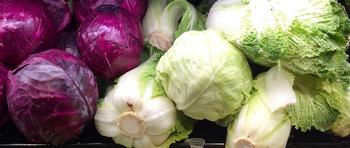Cabbages
Nov. 18, 2024 simplified layout, updated links.

See tips for using and preserving cabbages below.
NOTE: Research on food preservation is ongoing - recommendations may change. Make sure your preservation information is always current. Always follow up-to-date, tested guidelines and recipes from reliable sources.
Fresh Cabbage
Excerpts from University of Illinois Extension, Cabbage (Nov. 18, 2024 broken link: https://web.extension.illinois.edu/veggies/cabbage.cfm )
Selection and Storage
Look for tight, heavy heads, free of insects and decay. Fresh, uncut heads of cabbage can be stored in the refrigerator for up to two weeks. Cover loosely with a plastic bag or use perforated bags. Do not wash cabbage before storing, the extra moisture will hasten deterioration.
Preparation and Serving
The top portion of the cabbage head is more tender and shreds easier than the bottom. If it is practical, cut the head horizontal and use the top, raw in salads and slaw and use the bottom half in cooked recipes.
Cabbage is king of the cruciferous vegetable family. Sadly, many think of cabbage as an odoriferous and unpleasant vegetable. Cooked cabbage has been wrongfully accused of smelling-up kitchens and hallways everywhere. But don't blame the cabbage, blame the cook. The notorious odor problem is a result of over cooking... Cook just until tender and use stainless steel pots and pans.
The University of Alaska Fairbanks agrees, saying:
Cabbage is best in flavor and nutrition when eaten raw or cooked for a short period of time in a small amount of water. Overcooking tends to destroy flavor, appearance and vitamins, and it increases the sulfur odor."
Their publication FNH-00561C Cabbage has more information and recipes for using raw and cooked cabbage.
Freezing Fresh Cabbage
Excerpts from PennState Extension, Let's Preserve: Freezing Vegetables
Freezing is a quick, convenient, and easy method of preserving foods in the home. Frozen foods are easy to serve because most of the preparation is done before freezing. Freezing preserves nutritive quality so that frozen foods resemble fresh foods.
Successful Freezing: The five factors that are responsible for most of the quality losses of frozen foods are enzymes, air, microorganisms, large ice crystals, and evaporation of moisture... proper packaging materials helps prevent freezer burn.
Blanching Directions
- Bring 1 gallon of water to an active boil. Lower 1 pound of vegetables into the water. Cover. Return to a boil. Start counting the blanching time when the water returns to a boil.
- Blanching Time for Cabbage
quarters: 4 minutes; wedges: 2 minutes; shredded: 1½ minutes - As soon as blanching is complete, vegetables should be cooled quickly in 3 to 4 gallons of cold water.
- Chill at least as long as vegetables were blanched.
- Drain.
- Package.
Excerpt from University of Missouri Extension, How to Freeze Vegetables
Thawing and Using
- ... greens will cook more uniformly if thawed slightly and broken apart before cooking. Thaw in the refrigerator or under cold running water. Never thaw at room temperature.
- When cooking frozen vegetables, bring a small amount of water to boil and add the frozen vegetables. Bring water to a boil again, cover the pan, and lower the heat. Cook until vegetables are fork tender, usually about half the cooking time for the same fresh vegetable. [for] soups or stews. Add them near the end of cooking to prevent texture loss.
- Prepare only enough frozen vegetables for one meal. Any leftovers could be used in salad. Do not refreeze frozen vegetables that have been cooked.
Drying Cabbage
Extracted from University of Nebraska factsheet "Drying Vegetables"
Dried vegetables are frequently used in soups and stews.
Cabbage is considered fairly suitable for drying because it readily absorbs moisture from the air, and it keeps well only if stored at an extremely cold temperature.
To prepare cabbage for drying: Remove outer leaves, quarter & core; cut into strips 1/8" thick; blanch by steam until wilted for 2-1/2 to 3 minutes or by water for 1-1/2 to 2 minutes. Dry in a dehydrator until brittle, about 10 to 12 hours.
Fermenting Cabbage
Watch the youtube video, Home Food Fermentation from the University of Minnesota Extension to learn about the food fermentation process and food safety.
Sauerkraut and kimchi are two condiments that are made by lactic acid fermentation of cabbage and Napa cabbage, respectively.
Colorado State Extension Preservation Recipes
- Understanding and Making Sauerkraut explains what sauerkraut is and how to make it from red or green cabbage.
- Understanding and Making Kimchi gives information about kimchi and how to make it using Napa cabbage.
The University of Alaska Extension youtube video on Making Sauerkraut shows how to prepare cabbage for making sauerkraut, how to process the cabbage for fermenting in both large and small containers, and explains how to store sauerkraut and causes of spoilage.
Watch the youtube video, Making Kimchi with Julie Sawyer, Extension Agent from North Carolina Cooperative Extension, Haywood county, to learn how to make Kimchi (a savory side dish of fermented vegetables).
Canning Cabbage
We recommend that you follow a research-tested recipe and the USDA-approved procedures when canning.
If you are new to canning or want a review of the principles of home canning or the steps to safely canning at home, read Chapter 1 of USDA "Complete Guide to Home Canning", 2015.
Steam canning is now approved for recipes designed and tested for boiling-water canners. Read the UCANR publication #8573, Guidelines for Safe Canning of Acid Foods in a Steam Canner.
UCANR, Resource for Recipes & Information lists a few of the many sources that we use.
Cabbage is a low-acid food which would require pressure canning. However, Michigan State Extension, preserving tips does not recommend canning plain cabbage "because of the possibility of discolorations and strong flavor".
The following tested boiling-water canning recipes from the National Center for Home Food Preservation use cabbage and add sufficient acid (in the form of vinegar) to make a high-acid food product. Follow the recipe directions exactly.
